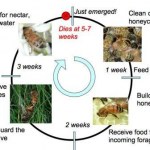Last week, my SciBling Jason Goldman interviewed me for his blog. The questions were not so much about blogging, journalism, Open Access and PLoS (except a little bit at the end) but more about science - how I got into it, what are my grad school experiences, what I think about doing research on animals, and such stuff. Jason posted the interview here, on his blog, on Friday, and he also let me repost it here on my blog as well, under the fold:
Here at Thoughtful Animal headquarters, we're starting a new series of seven-question interviews with people who are doing or have done animal…
chronobiology
Blame 'Night of the Living Dead' for this, but many people mistakenly think that zombies are nocturnal, going around their business of walking around town with stilted gaits, looking for people whose brains they can eat, only at night.
You think you are safe during the day? You are dangerously wrong!
Zombies are on the prowl at all times of day and night! They are not nocturnal, they are arrhythmic! And insomniac. They never sleep!
Remember how one becomes a zombie in the first place? Through death, or Intercision, or, since this is a science blog and we need to explain this scientifically,…
Whenever I read a paper from Karl-Arne Stokkan's lab, and I have read every one of them, no matter how dense the scientese language I always start imagining them running around the cold, dark Arctic, wielding enormous butterfly nets, looking for and catching reindeer (or ptarmigans, whichever animal the paper is about) to do their research.
If I was not so averse to cold, I'd think this would be the best career in science ever!
It is no surprise that their latest paper - A Circadian Clock Is Not Required in an Arctic Mammal (press release) - was widely covered by the media, both…
I am not the only one on ScienceBlogs.com to write about circadian rhythms, sleep and (non-visual) photoreception. Over the years, my SciBlings have written about these and related topics as well. Here is a sampler - go and dig for more on their blogs.
Stimulant Improves Sleep
Locked-In Syndrome
Opioids and Sleep Disorders
Home Testing for Sleep Apnea?
Pure Hypomanics: Living Zippedy Doo Dah Lives?
SFN Update: Sleep Deprivation Impacts Memory, Reduces Hippocampal Activity
Data Faker Turns Himself In
Agomelatine: A New Approach For Depression
Casual Fridays: Dave FINALLY finishes analyzing the…
Victor Bruce, a lecturer emeritus in biology at Princeton who conducted advanced studies for more than 25 years on the built-in cycles governing natural rhythms like the sleep-wake cycle, has died. He was 88.
Bruce, who despite a background in engineering became drawn to biological studies, died Friday, May 29, at his home in Princeton after a short struggle with cancer.
"He was an A-1 scientist who did some really neat work," said John Bonner, Princeton's George M. Moffett Professor Emeritus of Biology. "He was a wonderful colleague."
Bruce joined the Department of Biological Sciences in…
If you ever glanced at the circadian literature, you have probably encountered the statement that "circadian rhythms are ubiquitous in living systems". In all of my formal and informal writing I qualified that statement somewhat, stating something along the lines of "most organisms living on or near the Earth's surface have circadian rhythms". Why?
In the earliest days of chronobiology, it made sense to do most of the work on readily available organisms: plants, insects, mammals and birds. During the 20th century, thousands of species of animals, fungi, protists and plants - all living on…
Most people are aware that social insects, like honeybees, have three "sexes": queens, drones and workers.
Drones are males. Their only job is to fly out and mate with the queen after which they drop dead.
Female larvae fed 'royal jelly' emerge as queens. After mating, the young queen takes a bunch of workers with her and sets up a new colony. She lives much longer than other bees and spends her life laying gazillions of eggs continuously around the clock, while being fed by workers.
Female larvae not fed the 'royal jelly' emerge as workers.
Workers perform a variety of jobs in the hive.…
Nice four articles:
The Gears of the Sleep Clock By Allan Pack:
When people have trouble sleeping--such as, in extreme cases, shift workers--those problems are not always rooted in disturbances in circadian rhythm, argues the University of Pennsylvania's ALLAN PACK. Instead, his studies of sleep have shown that the master clock is only one player in the molecular control of sleep.
Sleep adjusts fly synapses by Bob Grant:
New findings support a controversial hypothesis about the biological role of sleep: Snoozing may be a way for the brain to clear clutter accumulated after a hard day of…
Yup, it's tonight.
If you were around here a few months ago, the day after the Fall Back day, you probably read this post.
Disregarding the debate over rhetoric of science, that is probably my best, most detailed explanation for what happens to our bodies on those too strange days of the year - Spring Forward and Fall Back day.
Spring Forward is much more dangerous, so be very careful in the mornings next week, especially on Monday. Take it easy, get up slowly, be a little late for work if you can afford it. Life and health are more important than a few minutes of work and being punctual on…
The 2009 Gordon Conference on Chronobiology is all molecular, and it is tough to get in anyway. It would be nice to go, but I don't see how I can get invited and/or funded.
XI Congress of the European Biological Rhythms Society, organized in association with the Japanese Society for Chronobiology
Hmmmm, Strasbourg in August. Fun for the family to do stuff while I chat with fellow chronobiologists, and just a short flight away from Belgrade.... Have to investigate if there's a way for me to go....
And the program looks interesting...
Long-time readers of this blog remember that, some years ago, I did a nifty little study on the Influence of Light Cycle on Dominance Status and Aggression in Crayfish. The department has moved to a new building, the crayfish lab is gone, I am out of science, so chances of following up on that study are very low. And what we did was too small even for a Least Publishable Unit, so, in order to have the scientific community aware of our results, I posted them (with agreement from my co-authors) on my blog. So, although I myself am unlikely to continue studying the relationship between the…
It is with great sadness that I learned that Dr.Greg Cahill died a few days ago, at the Houston airport, waiting for his flight. I have met Greg at several meetings of the Society for Research on Biological Rhythms and while, those being fairly large meetings, we never had big one-on-one conversations, I remember him as a humble and friendly person, beloved by everyone.
He started his scientific career in Mike Menaker's lab, studying the entrainment of the mammalian clock in the suprachiasmatic nucleus in vitro. Making preparations of SCN and optic tracts and doing electrophysiology on such…
This EurekAlert title got my attention this morning: Immunity stronger at night than during day:
The immune system's battle against invading bacteria reaches its peak activity at night and is lowest during the day.
Experiments with the laboratory model organism, Drosophila melanogaster, reveal that the specific immune response known as phagocytosis oscillates with the body's circadian rhythm, according to Stanford researchers who presented their findings at the American Society for Cell Biology (ASCB) 48th Annual Meeting, Dec. 13-17, 2008 in San Francisco.
"These results suggest that immunity…
Totally cool:
Phase Coupling of a Circadian Neuropeptide With Rest/Activity Rhythms Detected Using a Membrane-Tethered Spider Toxin:
The regulation of the daily fluctuations that characterize an organism's physiology and behavior requires coordination of the cellular oscillations of individual "clock" neurons within the circadian control network. Clock neurons that secrete a neuropeptide called pigment dispersing factor (PDF) calibrate, or entrain, both the phase of organismal rhythms and the cellular oscillations of other clock neurons. In this study, we tested the hypothesis that phase of…
If you live in (most places in) the United States as well as many other countries, you have reset your clocks back by one hour last night (or last week). How will that affect you and other people?
One possibility is that you are less likely to suffer a heart attack tomorrow morning than on any other Monday of the year. Why? Let me try to explain in as simple way as possible (hoping that oversimplification will not lead to intolerable degrees of inaccuracy).
Almost all biochemical, physiological and behavioral parameters in almost all (at least multicellular) organisms display diurnal (daily…
The October issue of the Journal of Biological Rhythms came in late last week - the only scientific journal I get in hard-copy these days. Along with several other interesting articles, one that immediately drew my attention was Clock Gene Wikis Available: Join the 'Long Tail' by John B. Hogenesch and Andrew I. Su (J Biol Rhythms 2008 23: 456-457.), especially since John Hogenesh and I talked about it in May at the SRBR meeting.
Now some of you may be quick to make a connection between this article and its author Andrew Su and A Gene Wiki for Community Annotation of Gene Function, published…
PLoS ONE has already published a large number of papers in chronobiology. But we want more. Hey, I work there - I want to see more.
So, when I went to the SRBR meeting in May, I did whatever I could to explain how PLoS ONE works and why my colleagues in the field should consider publishing with PLoS.
One thing we neeeded to give potential authors confidence is to add more chronobiologists to our Editorial Board in order to ensure that their mansucripts will be handled (and thus reviewed) by the experts in the field.
So, I am very happy to announce that we have secured editorial services…
As I announced this morning, there will be several guest posts here over the next several weeks. The first one, by Barn Owl of the lovely Guadalupe Storm-Petrel blog, is likely to appeal to a lot of my readers as it combines several of my own interests:
====================
In this guest-post for A Blog Around the Clock, I'll combine three things that Coturnix especially likes: horses, circadian biology, and an Open Access research paper. For the equestrian, there are two main seasonal issues, controlled primarily by photoperiod, or day length, which must be considered, especially if one…
Glow worms glimmer on cue:
University of Queensland researcher and lecturer Dr David Merritt has discovered that Tasmanian cave glow-worms are energy conservationists: they switch their lights off at night-time.
The discovery was made during a partially funded UQ Firstlink study, which revealed that the glow-worm's prey-luring light output is governed by circadian rhythms, regardless of ambient light levels.
The study aimed to investigate the physiology and behaviours of cave dwelling glow-worms, which are actually the immature or larval stage of a mosquito-like fly found in Queensland, New…


